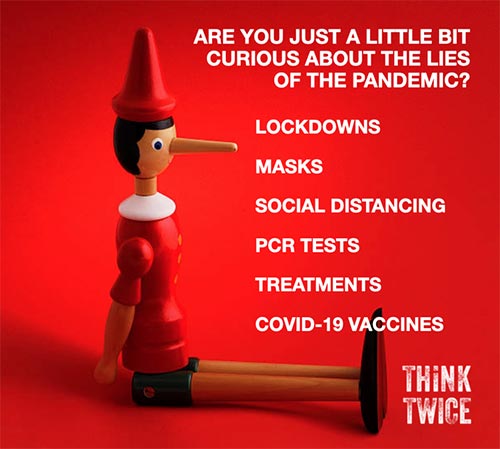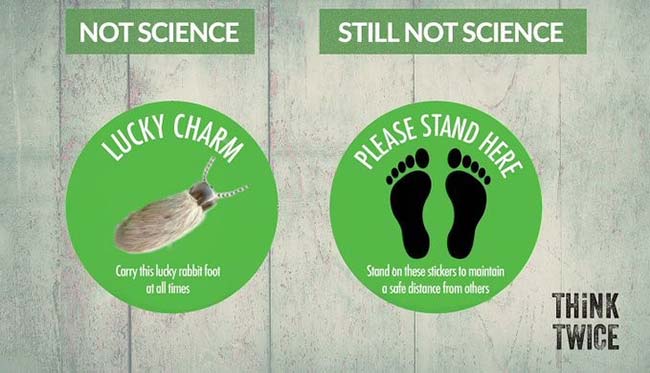by Dr. Joseph Mercola, Mercola:

STORY AT-A-GLANCE
- Lockdowns, social distancing, school and business closures, universal mask wearing, use of face shields and plastic barriers, travel restrictions, the use of PCR tests to diagnose infection, the choice of treatments and the safety and effectiveness of the COVID jabs — all of these countermeasures were based on a combination of lies, fraud and/or willful ignorance
TRUTH LIVES on at https://sgtreport.tv/
- Universal lockdowns have never before been used as a pandemic prevention measure, and for good reason. It doesn’t work. To prevent spread of infection, you isolate those who are actually sick. Healthy people cannot spread infection, so there’s no reason to isolate them
- An August 2020 analysis of COVID-19 surveillance data from the top 50 countries in terms of reported cases also concluded that border closures, lockdowns and wide-spread testing had no impact on COVID-19 mortality per million people. Another paper published in 2021 found lockdowns were actually associated with increases in excess mortality
- The absence of evidence to support mask wearing for infection control was confirmed from the very beginning by the same agencies and organizations that ended up recommending and/or mandating universal mask wearing
- To avoid making the same mistakes in future pandemics, medical crises must not be managed by means of emergency powers. Emergency powers should be used only in case of war
At this point, the lies we’ve been told about COVID countermeasures are so numerous, it would be easier to point to what was right and correct than list what was wrong, because the “correct” list would basically be blank.
Lockdowns, social distancing, school and business closures, universal mask wearing, use of face shields and plastic barriers, travel restrictions, the use of PCR tests to diagnose infection, the choice of treatments and the safety and effectiveness of the COVID jabs — all of these countermeasures were based on a combination of lies, fraud and/or willful ignorance. As tweeted by journalist Abir Ballan, co-founder of the Think Twice campaign:1
“Knowing whether you’ve been lied to or not is very important for deciding whether you should be angry or not … Turning a blind eye to the lies, won’t make them go away. They happened. You need to find the courage to face them.”

Here’s a review of what some of these strategies actually accomplished, and why we must never allow unilateral edicts by people with emergency powers to dictate pandemic responses ever again.
Lockdowns Flattened Economies
As reported by Pandemics Data & Analysis (PANDA)2 — a multidisciplinary initiative that seeks to inform policy — universal lockdowns have never before been used as a pandemic prevention measure, and for good reason. It doesn’t work. To prevent spread of infection, you isolate those who are actually sick. That’s how it has always been done.
Healthy people cannot spread infection, so there’s no reason to isolate them. This is about as common sense as things get, yet the World Health Organization opted to take a page from China, which locked down Wuhan as the infection began to spread.
Lockdowns were, however, a central feature in the Rockefeller Foundation’s “Scenarios for the Future of Technology and International Development” report,3 published in May 2010, in which they lay out an international “Lockstep” scenario that details their proposed response to a lethal pandemic.
“After many months of sustained lockdowns throughout the world, we now have empirical evidence demonstrating that they are not only ineffective, but cause greater harm than they seek to prevent and increase mortality. Applying a cure that is worse than the diseases is perhaps the worst manifestation of the mishandling of the COVID-19 pandemic,” PANDA reports.4
As one would expect, shutting down businesses for extended periods of time leads to businesses going under for impaired cash flow from lack of revenue. There was never any rhyme or reason for shutting down small businesses while keeping large box stores open, other than to shift wealth away from small, private business owners to multinational corporations.
By September 2020,5 163,735 U.S. businesses had closed their doors, and of those, 60% — a total of 97,966 businesses — were permanent closures.6 As noted by attorney Michael P. Senger,7 “That ‘leaders’ across the world transformed into tyrants, believing they had a right to bankrupt their subjects, is the core evil of lockdown.”
Indeed, far from being the great equalizer, COVID-19 has been the greatest wealth transfer scheme in the history of the world. Indeed, you may as well call it what it is: grand-scale asset theft from the poor and middle class.
Lockdowns Had No Effect on Infection Rates or Mortality
Meanwhile, study after study8,9,10 has confirmed that lockdowns had no beneficial impact on infection rates and COVID mortality. Among them, a study from Northern Jutland, which concluded that:11
“… while infection levels decreased, they did so before lockdown was effective, and infection numbers also decreased in neighbor municipalities without mandates. Direct spill-over to neighbor municipalities or the simultaneous mass testing do not explain this.
Instead, control of infection pockets possibly together with voluntary social behavior was apparently effective before the mandate, explaining why the infection decline occurred before and in both the mandated and non-mandated areas.”
An August 2020 analysis12 of COVID-19 surveillance data from the top 50 countries in terms of reported cases also concluded that border closures, lockdowns and wide-spread testing had no impact on COVID-19 mortality per million people. Another paper13 published in 2021 found lockdowns were actually associated with increases in excess mortality.
A 2022 literature review and meta-analysis14 of the effects of lockdowns also concluded that “lockdowns have had little to no effect on COVID-19 mortality.” They have, however, “imposed enormous economic and social costs.” As noted by the authors of this review, “lockdown policies are ill-founded and should be rejected as a pandemic policy instrument.”
Modeling Versus Empirical Data
Time and again, we’ve seen how statistical modeling has failed, making wildly inaccurate predictions about risk. This holds true for lockdown models as well. According to Oliver Robinson, a psychology professor at the University of Greenwich:15,16
“Lockdowns are associated with reduced mortality in epidemiological modelling studies but not in studies based on empirical data from the Covid-19 pandemic … Lockdowns may exacerbate stressors such as social isolation and unemployment that have been shown to be strong predictors of falling ill if exposed to a respiratory virus …
Economic level of analysis points to the possibility that deaths associated with economic harms or underfunding of other health issues may outweigh the deaths that lockdowns save, and that the extremely high financial cost of lockdowns may have negative implications for overall population health in terms of diminished resources for treating other conditions.”
Effects of Lockdowns
Studies looking at the social effects of lockdowns have also come to the following conclusions:
- The unemployment shock, being two to five times greater than the typical unemployment shock, will likely significantly increase mortality rates and lower life expectancy.17 The authors estimate unemployment shock alone will translate into an additional 0.8 million premature deaths
- Social isolation has led to a significant increase in mental health problems, addiction disorders, overdose deaths, child abuse and domestic violence rates18 and suicide ideation rates among youth19
- Lockdowns are at least five to 10 times more harmful to public health in terms of well-being years than COVID-19 itself20
- In Israel, an estimated 500,000 life-years have been lost to lockdowns due to income losses alone21
- In England, an estimated 59, 204 to 63, 229 years of life will be lost to four common cancers due to delays in diagnosis during lockdowns22
The Social Distancing Farce
The evidence behind 6-foot social distancing rules were equally nonexistent. As noted by Ballan in a January 26, 2023, tweet, all social distancing did — and was intended to do — was to make people afraid of each other:23
“The virus spreads through aerosols in the air. It doesn’t matter where you stand. Stickers on the floor don’t protect you. They just break social cohesion.”

There Was Never Any Support for Universal Masking
Universal masking mandates were also unfounded. As noted by PANDA:24
“There is very limited research on the effectiveness of masks or the potential harms of their prolonged use in the general public. The available literature indicates little scientific evidence that mask-wearing among the general public curbs disease spread.”
Remarkably, the absence of evidence to support mask wearing for infection control were confirmed from the very beginning by the same agencies and organizations that ended up recommending and/or mandating universal mask wearing.
For example, a Centers for Disease Control and Prevention policy review paper, published in May 2020, concluded that there’s “no evidence that surgical-type face masks are effective in reducing laboratory-confirmed influenza transmission, either when worn by infected persons (source control) or by persons in the general community to reduce their susceptibility.”25
Similarly, interim guidance by the World Health Organization, published in June 2020, stated: “At present, there is no direct evidence (from studies on COVID-19 and in healthy people in the community) on the effectiveness of universal masking of healthy people in the community to prevent infection with respiratory viruses, including COVID-19.”26
A systemic review by the Cochrane Library, published in November 2020, supported these views, noting that:27
“The pooled results of randomized trials did not show a clear reduction in respiratory viral infection with the use of medical/surgical masks during seasonal influenza. There were no clear differences between the use of medical/surgical masks compared with N95/P2 respirators in healthcare workers when used in routine care to reduce respiratory viral infection.”
The Cochrane Library’s 2023 update, which included 11 new studies, including some COVID-specific investigations, confirmed there still was no evidence to support universal masking recommendations.28,29,30,31,32
A randomized controlled trial33 in Denmark, which looked at COVID-19 infection specifically, also concluded there was “a non-statistically significant difference between two groups of participants, one requested to wear a mask, the other not wearing a mask,” and that masks were ineffective against virus-laden aerosols, as airborne viruses can “penetrate or circumnavigate a face mask.”
Similarly, a May 2020 study34 found no difference in case rates between U.S. states that had mask mandates compared to those that didn’t, and a British survey35 of infection rates among school children found “no evidence that face coverings, 2-metre social distancing or stopping children mixing was associated with lower odds of COVID-19 or cold infection rates in the school.”
Mask Harms Revealed
On the other hand, we now have evidence showing that mask wearing can cause harm, and again, some of this evidence comes from the WHO itself. For example, in its December 2020 interim guidance on masks,36 the WHO noted that mask disadvantages included “a false sense of security,” and that:
“Several studies have demonstrated statistically significant deleterious effects [of masks] on various cardiopulmonary physiologic parameters during mild to moderate exercise in healthy subjects and in those with underlying respiratory diseases.”
A German registry of reported effects among children found 68% experienced some sort of impairment, such as irritability, headache, poor concentration, reduced happiness, reluctance to go to school, general malaise, impaired learning and fatigue.37



 Mike Cernovich Says The Deep State and Ukraine Plotted The Assassination Attempts on President Trump:
Mike Cernovich Says The Deep State and Ukraine Plotted The Assassination Attempts on President Trump: